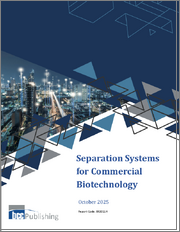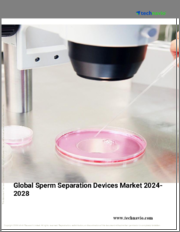
|
시장보고서
상품코드
1722760
상업 바이오테크놀러지용 분리 시스템 시장 보고서 : 방법, 용도, 지역별(2025-2033년)Separation Systems for Commercial Biotechnology Market Report by Methods (Modern Methods, Conventional Methods), Application (Pharmaceutical, Food and Cosmetics, Agriculture, and Others), and Region 2025-2033 |
||||||
세계 상업 바이오테크놀러지용 분리 시스템 시장 규모는 2024년 282억 달러에 달했습니다. 향후 IMARC Group은 2033년에는 447억 달러에 달하고, 2025-2033년 4.98%의 연평균 성장률(CAGR)을 보일 것으로 전망하고 있습니다.
상업 바이오테크놀러지용 분리 시스템은 생화학 물질, 진단 시약, 바이오 의약품을 포함한 복잡한 혼합물이나 용액에서 생물학적 제품을 정제 및 분리하는 데 사용되는 솔루션을 말합니다. 분리는 제품의 정전하, 밀도, 형태, 극성, 용해도, 확산성, 휘발성에 따라 이루어집니다. 분리에는 크로마토그래프, 멤브레인, 필터, 원심분리기, 바이오칩, 마이크로어레이 등 다양한 기기 및 장치가 사용됩니다. 이러한 솔루션은 수지의 생산성을 향상시키고, 회수율을 높이며, 폐기물 발생과 세척수 사용을 최소화합니다. 그 결과, 분리 시스템은 제약, 식음료, 화장품, 농업 등 다양한 산업에서 폭넓게 사용되고 있습니다.
상업 바이오테크놀러지용 분리 시스템 시장 동향 :
세계 제약 산업의 괄목할만한 성장은 시장 전망을 밝게 하는 중요한 요인 중 하나입니다. 만성 질환이 증가함에 따라 맞춤형 의약품, 바이오 의약품 및 세포 기반 치료에 대한 수요가 증가하고 있으며, 이는 상업용 생명 공학용 분리 시스템에 대한 수요에 영향을 미치고 있습니다. 또한, 플라스틱 및 화학제품의 상업적 생산에 자기 분리기가 널리 채택되고 있는 것도 시장 성장의 원동력이 되고 있습니다. 또한, 간소화된 절차로 생물학적 위험 요소를 제품별로 제거하는 혁신적인 업스트림 바이오프로세스 기술의 개발 등 다양한 기술 발전이 성장을 가속하는 요인으로 작용하고 있습니다. 생명공학 연구소 및 연구기관들도 고감도 및 고분자 분리를 위해 새로운 고성능 가스 크로마토그래프, 초임계 유체 크로마토그래프, 원심분리, 전기영동 장치 등을 사용하고 있습니다. 이 외에도, 특히 신흥 경제국의 헬스케어 인프라 개선과 생명공학 분야의 광범위한 연구개발(R&D) 등이 시장 성장을 가속할 것으로 예측됩니다.
본 보고서에서 다룬 주요 질문
- 2024년 전 세계 상업 바이오테크놀러지용 분리 시스템 시장 규모는?
- 2025-2033년 상업 바이오테크놀러지용 분리 시스템 세계 시장의 예상 성장률은?
- 상업 바이오테크놀러지용 분리 시스템 세계 시장을 주도하는 주요 요인은?
- 코로나19가 상업 바이오테크놀러지용 분리 시스템 세계 시장에 미치는 영향은?
- 상업 바이오테크놀러지용 분리 시스템 세계 시장에서의 기술별 분류는?
- 세계 상업 바이오테크놀러지용 분리 시스템 시장의 용도별 분류는?
- 상업 바이오테크놀러지용 분리 시스템 세계 시장의 주요 지역은?
- 상업 바이오테크놀러지용 분리 시스템 세계 시장의 주요 기업은?
목차
제1장 서문
제2장 조사 범위와 조사 방법
- 조사 목적
- 이해관계자
- 데이터 소스
- 1차 정보
- 2차 정보
- 시장 추정
- 보텀업 접근
- 톱다운 접근
- 조사 방법
제3장 주요 요약
제4장 서론
- 개요
- 주요 업계 동향
제5장 세계의 상업 바이오테크놀러지용 분리 시스템 시장
- 시장 개요
- 시장 실적
- COVID-19의 영향
- 시장 예측
제6장 시장 분석 : 방법별
- 현대적 방법
- 주요 부문
- 마이크로어레이
- 랩온어칩
- 자기 분리
- 기타
- 주요 부문
- 기존 방법
- 주요 부문
- 크로마토그래피
- 유세포분석기
- 막여과
- 기타
- 주요 부문
제7장 시장 분석 : 용도별
- 의약품
- 주요 부문
- 백신
- 단백질
- 호르몬 및 인슐린
- 효소
- 인간 혈장 분획
- 포유류 세포배양
- 주요 부문
- 식품 및 화장품
- 농업
- 기타
제8장 시장 분석 : 지역별
- 북미
- 미국
- 캐나다
- 아시아태평양
- 중국
- 일본
- 인도
- 한국
- 호주
- 인도네시아
- 기타
- 유럽
- 독일
- 프랑스
- 영국
- 이탈리아
- 스페인
- 러시아
- 기타
- 라틴아메리카
- 브라질
- 멕시코
- 기타
- 중동 및 아프리카
- 시장 내역 : 국가별
제9장 SWOT 분석
- 개요
- 강점
- 약점
- 기회
- 위협
제10장 밸류체인 분석
제11장 Porter의 Five Forces 분석
- 개요
- 바이어의 교섭력
- 공급 기업의 교섭력
- 경쟁 정도
- 신규 진출업체의 위협
- 대체품의 위협
제12장 가격 분석
제13장 경쟁 구도
- 시장 구조
- 주요 기업
- 주요 기업 개요
- Agilent Technologies Inc.
- Becton Dickinson and Company
- Bio-Rad Laboratories Inc.
- Hitachi Ltd.
- Merck KGaA
- Pall Corporation(Danaher Corporation)
- PerkinElmer Inc.
- Qiagen N.V
- Repligen Corporation
- Sartorius AG
- Shimadzu Corporation
- Thermo Fisher Scientific
The global separation systems for commercial biotechnology market size reached USD 28.2 Billion in 2024. Looking forward, IMARC Group expects the market to reach USD 44.7 Billion by 2033, exhibiting a growth rate (CAGR) of 4.98% during 2025-2033.
The separation systems for commercial biotechnology refer to the solutions used for the purification and separation of biological products from complex mixtures and solutions, including biochemicals, diagnostic reagents and biopharmaceuticals. The separation is based on the electrostatic charge, density, shape, polarity, solubility, diffusivity and volatility of the product. It involves the use of various equipment and devices, such as chromatographs, membranes, filters, centrifuges, biochips and microarrays. These solutions offer improved resin productivity, higher recovery and minimal waste generation and wash water usage. As a result, separation systems find extensive applications across various industries, including pharmaceutical, food and beverage, cosmetic and agriculture.
Separation Systems for Commercial Biotechnology Market Trends:
Significant growth in the pharmaceutical industry across the globe is one of the key factors creating a positive outlook for the market. With the increasing prevalence of chronic medical ailments, there is a rising demand for personalized drugs, biopharmaceuticals and cell-based therapies, which is impacting the demand for separation systems for commercial biotechnology. Moreover, the widespread adoption of magnetic separators for the commercial production of plastics and chemicals is providing a thrust to the market growth. Additionally, various technological advancements, such as the development of innovative upstream bioprocessing technologies that facilitate in the elimination of biohazardous by-products using simplified procedures, are acting as growth-inducing factors. Biotechnological institutes and research organizations are also using novel high-performance gas and supercritical fluid chromatography, centrifugation and electrophoresis equipment for the separation of sensitive and large molecules. Other factors, including improvements in the healthcare infrastructure, especially in the developing economies, along with extensive research and development (R&D) in the field of biotechnology, are anticipated to drive the market toward growth.
Key Market Segmentation:
Breakup by Methods:
- Modern Methods
- Microarray
- Lab-on-a-Chip
- Magnetic Separation
- Others
- Conventional Methods
- Chromatography
- Flow Cytometry
- Membrane Filtration
- Others
Breakup by Application:
- Pharmaceutical
- Vaccines
- Proteins
- Hormones and Insulin
- Enzymes
- Human Blood Plasma Fractionation
- Mammalian Cell Cultures
- Food and Cosmetics
- Agriculture
- Others
Breakup by Region:
- North America
- United States
- Canada
- Asia-Pacific
- China
- Japan
- India
- South Korea
- Australia
- Indonesia
- Others
- Europe
- Germany
- France
- United Kingdom
- Italy
- Spain
- Russia
- Others
- Latin America
- Brazil
- Mexico
- Others
- Middle East and Africa
Competitive Landscape:
The competitive landscape of the industry has also been examined along with the profiles of the key players being Agilent Technologies Inc., Becton Dickinson and Company, Bio-Rad Laboratories Inc., Hitachi Ltd., Merck KGaA, Pall Corporation (Danaher Corporation), PerkinElmer Inc., Qiagen N.V, Repligen Corporation, Sartorius AG, Shimadzu Corporation and Thermo Fisher Scientific.
Key Questions Answered in This Report
- 1.What was the size of the global separation systems for commercial biotechnology market in 2024?
- 2.What is the expected growth rate of the global separation systems for commercial biotechnology market during 2025-2033?
- 3.What are the key factors driving the global separation systems for commercial biotechnology market?
- 4.What has been the impact of COVID-19 on the global separation systems for commercial biotechnology market?
- 5.What is the breakup of the global separation systems for commercial biotechnology market based on the methods?
- 6.What is the breakup of the global separation systems for commercial biotechnology market based on the application?
- 7.What are the key regions in the global separation systems for commercial biotechnology market?
- 8.Who are the key players/companies in the global separation systems for commercial biotechnology market?
Table of Contents
1 Preface
2 Scope and Methodology
- 2.1 Objectives of the Study
- 2.2 Stakeholders
- 2.3 Data Sources
- 2.3.1 Primary Sources
- 2.3.2 Secondary Sources
- 2.4 Market Estimation
- 2.4.1 Bottom-Up Approach
- 2.4.2 Top-Down Approach
- 2.5 Forecasting Methodology
3 Executive Summary
4 Introduction
- 4.1 Overview
- 4.2 Key Industry Trends
5 Global Separation Systems for Commercial Biotechnology Market
- 5.1 Market Overview
- 5.2 Market Performance
- 5.3 Impact of COVID-19
- 5.4 Market Forecast
6 Market Breakup by Methods
- 6.1 Modern Methods
- 6.1.1 Market Trends
- 6.1.2 Key Segments
- 6.1.2.1 Microarray
- 6.1.2.2 Lab-on-a-Chip
- 6.1.2.3 Magnetic Separation
- 6.1.2.4 Others
- 6.1.3 Market Forecast
- 6.2 Conventional Methods
- 6.2.1 Market Trends
- 6.2.2 Key Segments
- 6.2.2.1 Chromatography
- 6.2.2.2 Flow Cytometry
- 6.2.2.3 Membrane Filtration
- 6.2.2.4 Others
- 6.2.3 Market Forecast
7 Market Breakup by Application
- 7.1 Pharmaceutical
- 7.1.1 Market Trends
- 7.1.2 Key Segments
- 7.1.2.1 Vaccines
- 7.1.2.2 Proteins
- 7.1.2.3 Hormones and Insulin
- 7.1.2.4 Enzymes
- 7.1.2.5 Human Blood Plasma Fractionation
- 7.1.2.6 Mammalian Cell Cultures
- 7.1.3 Market Forecast
- 7.2 Food and Cosmetics
- 7.2.1 Market Trends
- 7.2.2 Market Forecast
- 7.3 Agriculture
- 7.3.1 Market Trends
- 7.3.2 Market Forecast
- 7.4 Others
- 7.4.1 Market Trends
- 7.4.2 Market Forecast
8 Market Breakup by Region
- 8.1 North America
- 8.1.1 United States
- 8.1.1.1 Market Trends
- 8.1.1.2 Market Forecast
- 8.1.2 Canada
- 8.1.2.1 Market Trends
- 8.1.2.2 Market Forecast
- 8.1.1 United States
- 8.2 Asia-Pacific
- 8.2.1 China
- 8.2.1.1 Market Trends
- 8.2.1.2 Market Forecast
- 8.2.2 Japan
- 8.2.2.1 Market Trends
- 8.2.2.2 Market Forecast
- 8.2.3 India
- 8.2.3.1 Market Trends
- 8.2.3.2 Market Forecast
- 8.2.4 South Korea
- 8.2.4.1 Market Trends
- 8.2.4.2 Market Forecast
- 8.2.5 Australia
- 8.2.5.1 Market Trends
- 8.2.5.2 Market Forecast
- 8.2.6 Indonesia
- 8.2.6.1 Market Trends
- 8.2.6.2 Market Forecast
- 8.2.7 Others
- 8.2.7.1 Market Trends
- 8.2.7.2 Market Forecast
- 8.2.1 China
- 8.3 Europe
- 8.3.1 Germany
- 8.3.1.1 Market Trends
- 8.3.1.2 Market Forecast
- 8.3.2 France
- 8.3.2.1 Market Trends
- 8.3.2.2 Market Forecast
- 8.3.3 United Kingdom
- 8.3.3.1 Market Trends
- 8.3.3.2 Market Forecast
- 8.3.4 Italy
- 8.3.4.1 Market Trends
- 8.3.4.2 Market Forecast
- 8.3.5 Spain
- 8.3.5.1 Market Trends
- 8.3.5.2 Market Forecast
- 8.3.6 Russia
- 8.3.6.1 Market Trends
- 8.3.6.2 Market Forecast
- 8.3.7 Others
- 8.3.7.1 Market Trends
- 8.3.7.2 Market Forecast
- 8.3.1 Germany
- 8.4 Latin America
- 8.4.1 Brazil
- 8.4.1.1 Market Trends
- 8.4.1.2 Market Forecast
- 8.4.2 Mexico
- 8.4.2.1 Market Trends
- 8.4.2.2 Market Forecast
- 8.4.3 Others
- 8.4.3.1 Market Trends
- 8.4.3.2 Market Forecast
- 8.4.1 Brazil
- 8.5 Middle East and Africa
- 8.5.1 Market Trends
- 8.5.2 Market Breakup by Country
- 8.5.3 Market Forecast
9 SWOT Analysis
- 9.1 Overview
- 9.2 Strengths
- 9.3 Weaknesses
- 9.4 Opportunities
- 9.5 Threats
10 Value Chain Analysis
11 Porters Five Forces Analysis
- 11.1 Overview
- 11.2 Bargaining Power of Buyers
- 11.3 Bargaining Power of Suppliers
- 11.4 Degree of Competition
- 11.5 Threat of New Entrants
- 11.6 Threat of Substitutes
12 Price Analysis
13 Competitive Landscape
- 13.1 Market Structure
- 13.2 Key Players
- 13.3 Profiles of Key Players
- 13.3.1 Agilent Technologies Inc.
- 13.3.1.1 Company Overview
- 13.3.1.2 Product Portfolio
- 13.3.1.3 Financials
- 13.3.1.4 SWOT Analysis
- 13.3.2 Becton Dickinson and Company
- 13.3.2.1 Company Overview
- 13.3.2.2 Product Portfolio
- 13.3.2.3 Financials
- 13.3.2.4 SWOT Analysis
- 13.3.3 Bio-Rad Laboratories Inc.
- 13.3.3.1 Company Overview
- 13.3.3.2 Product Portfolio
- 13.3.3.3 Financials
- 13.3.3.4 SWOT Analysis
- 13.3.4 Hitachi Ltd.
- 13.3.4.1 Company Overview
- 13.3.4.2 Product Portfolio
- 13.3.4.3 Financials
- 13.3.4.4 SWOT Analysis
- 13.3.5 Merck KGaA
- 13.3.5.1 Company Overview
- 13.3.5.2 Product Portfolio
- 13.3.5.3 Financials
- 13.3.6 Pall Corporation (Danaher Corporation)
- 13.3.6.1 Company Overview
- 13.3.6.2 Product Portfolio
- 13.3.6.3 SWOT Analysis
- 13.3.7 PerkinElmer Inc.
- 13.3.7.1 Company Overview
- 13.3.7.2 Product Portfolio
- 13.3.7.3 Financials
- 13.3.8 Qiagen N.V
- 13.3.8.1 Company Overview
- 13.3.8.2 Product Portfolio
- 13.3.8.3 Financials
- 13.3.8.4 SWOT Analysis
- 13.3.9 Repligen Corporation
- 13.3.9.1 Company Overview
- 13.3.9.2 Product Portfolio
- 13.3.9.3 Financials
- 13.3.10 Sartorius AG
- 13.3.10.1 Company Overview
- 13.3.10.2 Product Portfolio
- 13.3.10.3 Financials
- 13.3.10.4 SWOT Analysis
- 13.3.11 Shimadzu Corporation
- 13.3.11.1 Company Overview
- 13.3.11.2 Product Portfolio
- 13.3.11.3 Financials
- 13.3.11.4 SWOT Analysis
- 13.3.12 Thermo Fisher Scientific
- 13.3.12.1 Company Overview
- 13.3.12.2 Product Portfolio
- 13.3.12.3 Financials
- 13.3.12.4 SWOT Analysis
- 13.3.1 Agilent Technologies Inc.



















